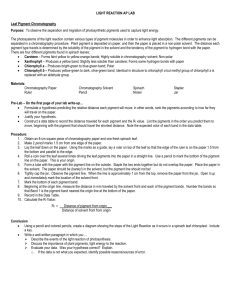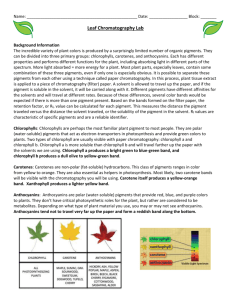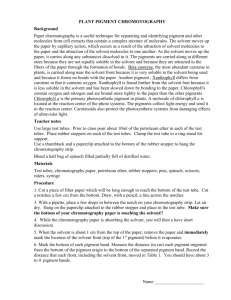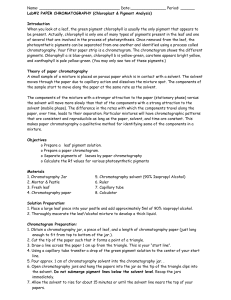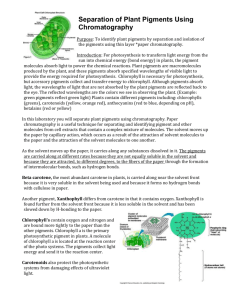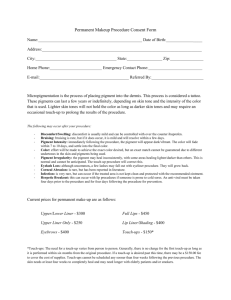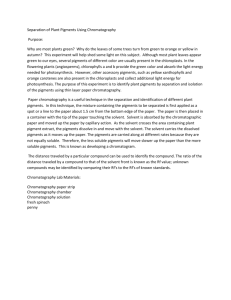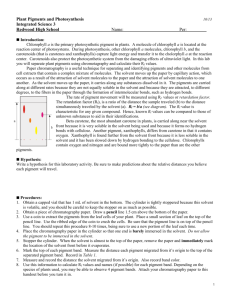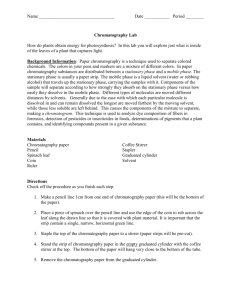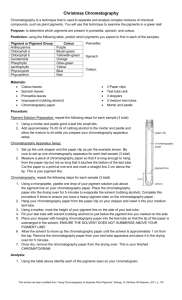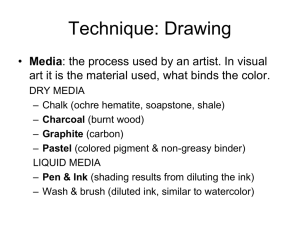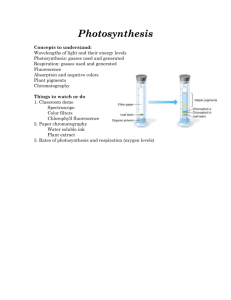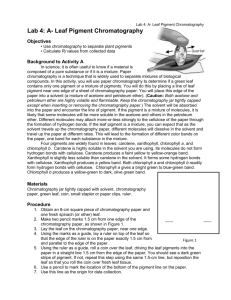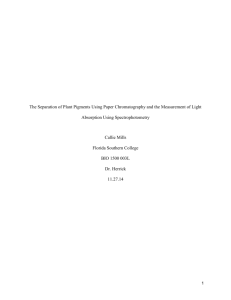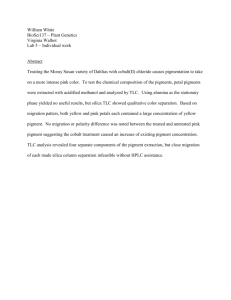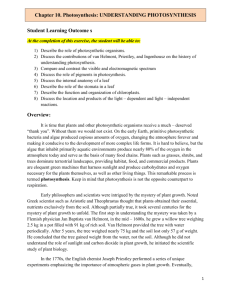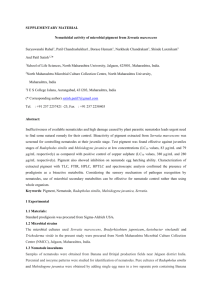Plant Pigments
advertisement
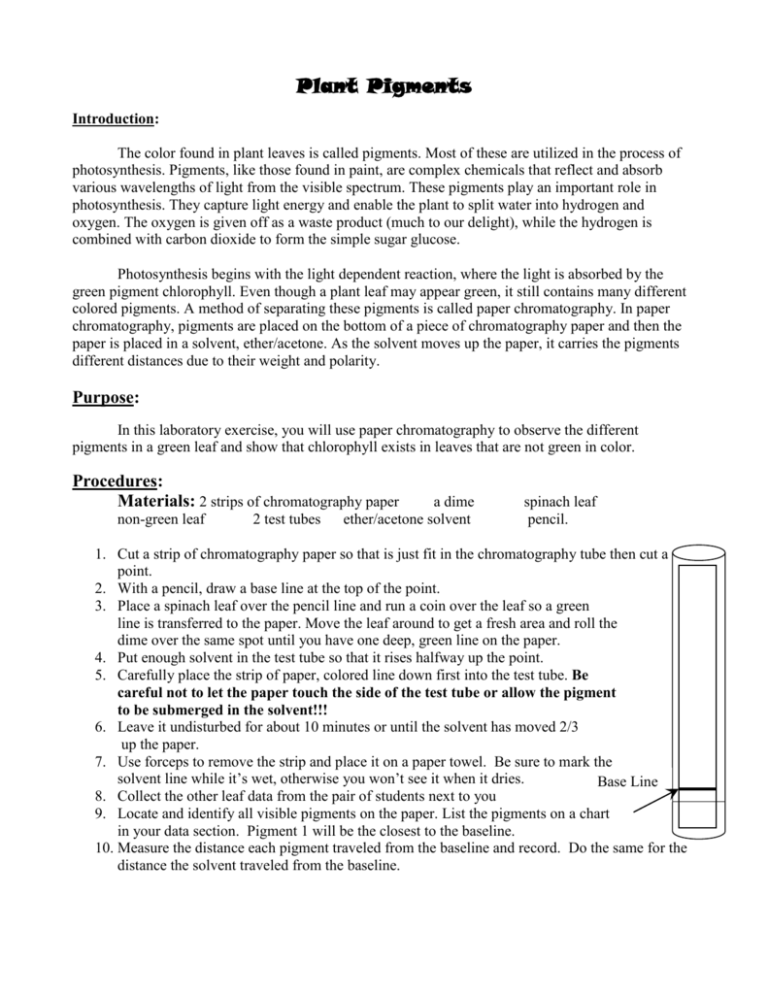
Plant Pigments Introduction: The color found in plant leaves is called pigments. Most of these are utilized in the process of photosynthesis. Pigments, like those found in paint, are complex chemicals that reflect and absorb various wavelengths of light from the visible spectrum. These pigments play an important role in photosynthesis. They capture light energy and enable the plant to split water into hydrogen and oxygen. The oxygen is given off as a waste product (much to our delight), while the hydrogen is combined with carbon dioxide to form the simple sugar glucose. Photosynthesis begins with the light dependent reaction, where the light is absorbed by the green pigment chlorophyll. Even though a plant leaf may appear green, it still contains many different colored pigments. A method of separating these pigments is called paper chromatography. In paper chromatography, pigments are placed on the bottom of a piece of chromatography paper and then the paper is placed in a solvent, ether/acetone. As the solvent moves up the paper, it carries the pigments different distances due to their weight and polarity. Purpose: In this laboratory exercise, you will use paper chromatography to observe the different pigments in a green leaf and show that chlorophyll exists in leaves that are not green in color. Procedures: Materials: 2 strips of chromatography paper non-green leaf 2 test tubes a dime ether/acetone solvent spinach leaf pencil. 1. Cut a strip of chromatography paper so that is just fit in the chromatography tube then cut a point. 2. With a pencil, draw a base line at the top of the point. 3. Place a spinach leaf over the pencil line and run a coin over the leaf so a green line is transferred to the paper. Move the leaf around to get a fresh area and roll the dime over the same spot until you have one deep, green line on the paper. 4. Put enough solvent in the test tube so that it rises halfway up the point. 5. Carefully place the strip of paper, colored line down first into the test tube. Be careful not to let the paper touch the side of the test tube or allow the pigment to be submerged in the solvent!!! 6. Leave it undisturbed for about 10 minutes or until the solvent has moved 2/3 up the paper. 7. Use forceps to remove the strip and place it on a paper towel. Be sure to mark the solvent line while it’s wet, otherwise you won’t see it when it dries. Base Line 8. Collect the other leaf data from the pair of students next to you 9. Locate and identify all visible pigments on the paper. List the pigments on a chart in your data section. Pigment 1 will be the closest to the baseline. 10. Measure the distance each pigment traveled from the baseline and record. Do the same for the distance the solvent traveled from the baseline. Color Pigment Yellow-Orange Carotene Yellow Xanthophyll Bright Green-Blue Green Chlorophyll a Yellow Green-Olive Green Chlorophyll b Red Anthocyanin Data: Rf value = Pigment distance traveled Solvent distance Pigment Source: _______________________ Original Color: ________________ Distance Traveled (mm) Solvent Distance (mm) Rf value Color Pigment Pigment 1 Pigment 2 Pigment 3 Pigment 4 Pigment 5 Pigment Source: _______________________ Original Color: ________________ Distance Traveled (mm) Solvent Distance (mm) Rf value Color Pigment Pigment 1 Pigment 2 Pigment 3 Pigment 4 Pigment 5 Analysis: 1. Besides photosynthesis, what might be another function of color in a plant? (Thought question) 2. Which pigment is the most important in photosynthesis? 3. What gas is needed to make glucose? 4. What color of wavelengths of light are absorbed by green plants? Reflected? 5. What are the accessory pigments functions? 6. Many trees have leaves that are green in the summer and red, yellow, and orange in autumn. Where were these colors during the summer? 7. How do plants that, such as the Plum cherry tree, produce glucose? Why do you think they are not green like most plants (refer to your answer from question 1)? Conclusion:

